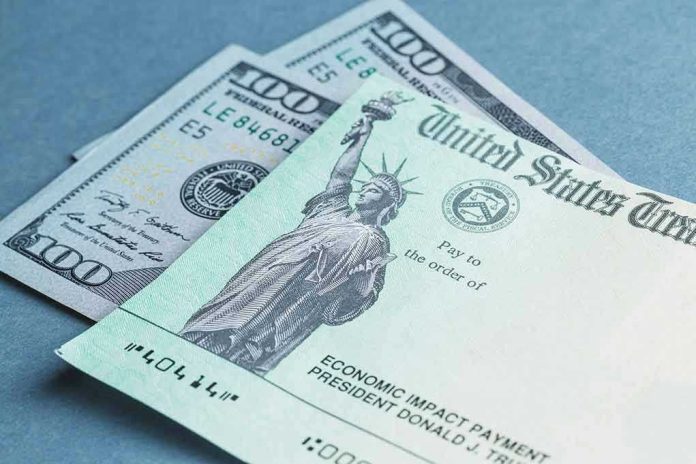🔴 Website 👉 https://u-s-news.com/
Telegram 👉 https://t.me/usnewscom_channel
Security at the heart of our nation’s financial power was breached when a man scaled the U.S. Treasury’s gate, setting off alarms not just at the building, but in the minds of everyone fed up with years of failed leadership and soft-on-crime policies that embolden these incidents.
At a Glance
- Man arrested after climbing the U.S. Treasury gate in Washington, D.C.; Secret Service responded swiftly.
- Metropolitan Police bomb squad called to investigate a suspicious bag; no explosives found.
- Incident follows a year of cyberattacks and rising threats targeting federal sites.
- Public concern grows over security vulnerabilities at critical government buildings.
Security Breach at the Treasury: A Wake-Up Call for Washington
Sunday afternoon, the Secret Service apprehended a man who managed to scale the security gate at the U.S. Treasury building, right in the heart of Washington, D.C. This wasn’t some minor trespass – this was a full-blown federal security breach, and it forced the government to call in the Metropolitan Police Department’s bomb squad to examine a bag the suspect brought with him. The response, by all accounts, was immediate and thorough, blocking off traffic and locking down the area. But here’s the real question: how did we get to a point where individuals believe they can approach – let alone climb the gates of – one of our country’s most protected financial fortresses?
Man arrested at US Treasury building after climbing gate, agency says https://t.co/6DSXjOPMMl https://t.co/6DSXjOPMMl
— Reuters (@Reuters) July 28, 2025
This is what happens after years of hand-wringing, virtue signaling, and leftist politicians more interested in “restorative justice” than actual consequences. The suspect’s motivation remains unknown, but the message is clear as day: every time we signal weakness, someone tests the fence. And make no mistake, this is not an isolated event. It’s the result of our institutions being undermined from within – first by cyberattacks, now by physical incursions.
Security on the Edge: A Pattern of Federal Vulnerability
The Treasury isn’t just another government building. It’s a symbol of American financial strength, guarded for generations by layers of security. But the last few years have shown that even our most protected sites are not immune to threats. Just last December, the Treasury was hit by a major cyberattack attributed to Chinese state-backed hackers, exposing sensitive – if unclassified – government documents. That hack was a warning shot. Sunday’s physical breach was a siren. It’s not just about one incident; it’s about a pattern of lawlessness and disregard for American sovereignty, both online and on the ground.
Federal buildings in D.C. have seen a spike in both physical break-ins and digital intrusions. History tells us these incidents are rare, but they’re becoming more frequent, especially since the government’s priorities shifted toward appeasement and away from hard security. Each time a perimeter is breached, it chips away at public confidence in our ability to protect what matters most: our national security, our data, and our financial backbone.
The Real Cost: Eroded Confidence and Unanswered Questions
Immediate fallout from Sunday’s incident included traffic shutdowns and temporary disruption for Treasury staff and visitors. The bomb squad found no explosives, and the area was cleared – but the damage is done. In the long run, these events push the government toward more aggressive security measures, more taxpayer dollars spent on upgrades, and, inevitably, more inconvenience for law-abiding citizens who simply want to go about their lives without fear or interference. The real cost, though, is confidence. How many more “isolated incidents” will it take before Americans demand a return to common sense – and ironclad – security measures at our most important institutions?
We’ve seen the cost of letting our guard down: cyberattacks that threaten our financial system, physical breaches that risk personnel safety, and the nagging suspicion that those in charge are more concerned with optics than outcomes. The suspect’s identity and motives remain under wraps, but the pattern is painfully clear. Until we recognize that security is non-negotiable – and start electing leaders who treat it that way – we’ll keep seeing these headlines. It’s time to draw a line and defend it, literally and figuratively.
Lessons from the Front Line: What Experts Are Saying
Security experts are unanimous: a layered approach is the only way forward. Physical barriers, rapid law enforcement deployment, and high-tech surveillance must work hand in hand – and none can be allowed to fall behind. The Treasury’s recent cyberattack, combined with Sunday’s gate climber, underscores the need for relentless vigilance. Some analysts praise the swift response as proof the system works. Others argue that the very fact these breaches keep happening means more needs to be done. Both are right. We can’t afford complacency, and we can’t keep putting Band-Aids on bullet wounds.
Americans deserve a government that puts their safety and sovereignty first – not one that reacts only after the alarm bells ring. These incidents should be studied, yes, but they should also spur immediate action. Enough with the endless reviews and task forces. The message from everyday citizens is clear: fix the problems, protect our institutions, and stop treating national security like a political side show. That’s the only way to restore confidence and keep America safe, strong, and sovereign.
Sources:
CyberArk: The US Treasury Attack—Key Events and Security Implications
The Independent: Chinese hackers breach US Treasury in ‘major’ cyber attack
Texas Standard: China-backed hackers breached the US Treasury Department
U.S. Treasury: Burglar Proof Vault (historical context)
Government Contracts Law Blog: Lessons from the U.S. Treasury Cybersecurity Incident

